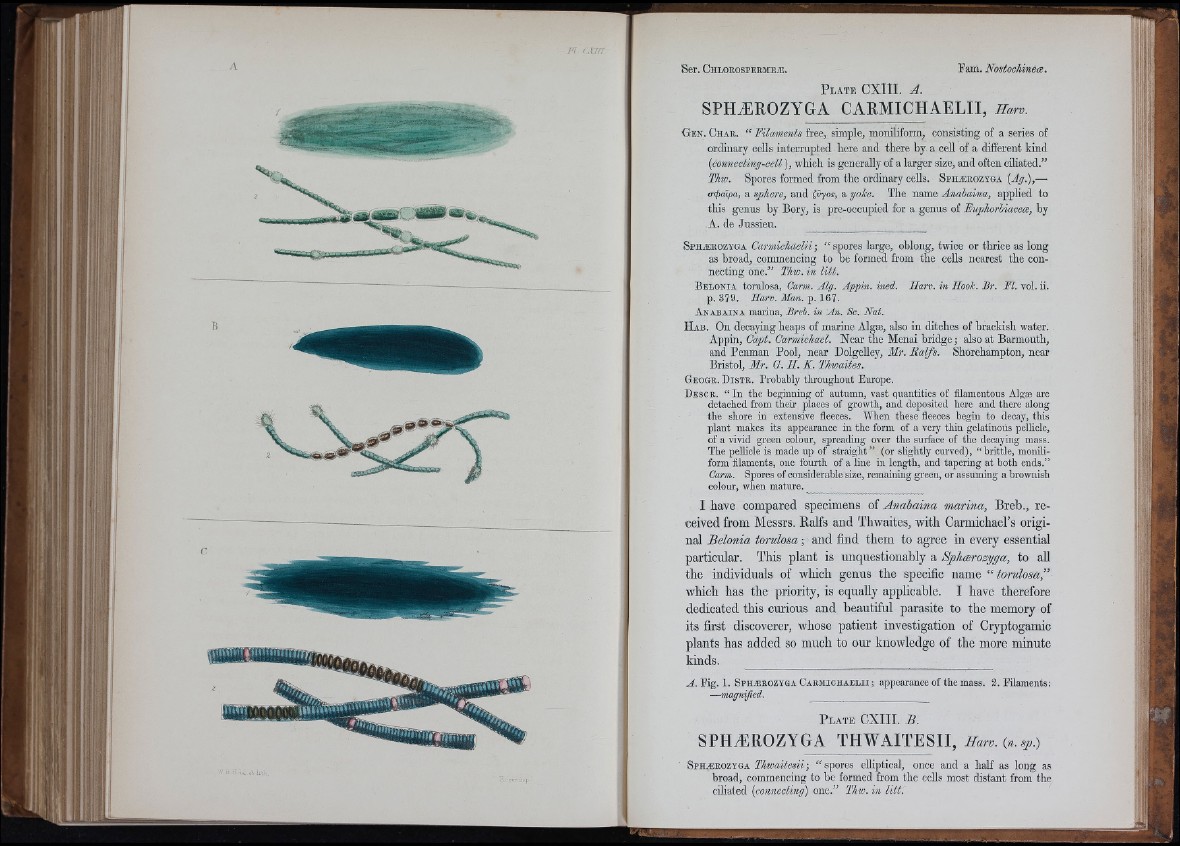
P l a t e CXIII. A.
SPHÆROZYGA CARMICHAELII, Harv.
G e n . C h a r . “ Filaments free, simple, moniliform, consisting of a series of
ordinary ceUs interrnpted here and there by a cell of a different kind
[connecting-cell ), which is generally of a larger size, and often ciliated.”
Thw. Spores formed from the ordinary ceUs. S p h æ ro z ïg a [Jg.),—
<T(j>aXpa, a sphere, and (iyor, a yoke. The name Anahaina, applied to
this genus by Bory, is pre-occupied for a genus of Fuphorhiacece, by
A. de Jussieu.
S p hæ ro z y g a Carmichaelii ; “ spores large, oblong, twice or thrice as long
as broad, commencing to be formed from the cells nearest the connecting
one.” Thw. in litt.
Belonia torulosa, Carm. Alg. Appin. ined. Harv. in Hook. Br. FI. vol. ii.
p. 379. Harv. Man. p. 167.
Anabaina marina, Breh. in An. Sc. Nat.
H a b . On decaying heaps of marine Algse, also in ditches of brackish water.
NpYm, Capt. Carmichael. Near the Menai bridge; also at Barmouth,
and Penman Pool, near DolgeUey, Mr. Ralfs. Shorehampton, near
Bristol, Mr. 0 . H. K. Thwaites.
Geogr. D is t e . Probably throughout Europe.
Desce. “ In the beginning of autumn, vast quantities of filamentous Algae are
detached from their places of groivth, and deposited here and there along
the shore in extensive fleeces. When these fleeces begin to decay, this
plant makes its appearance in the form of a very thin gelatinous pellicle,
of a vivid green colour, spreading over the surface of the decaying mass.
The pellicle is made up of stra ig h t” (or slightly curved), “ brittle, monüi-
form filaments, one fourth of a line in length, and tapering at both ends.”
Cam. Spores of considerable size, remaining green, or assuming a brownish
colour, when mature.
I have compared specimens of Anahaina marina, Breb., received
from Messrs. Ralfs and Thwaites, with Carmichael’s original
Belonia torulosa ; and find them to agree in every essential
particular. This plant is unquestionably a Sphærozyga, to all
the individuals of which genus the specific name “ torulosa f
which has the priority, is equally applicable. I have therefore
dedicated this curious and beautiful parasite to the memory of
its first discoverer, whose patient investigation of Cryptogamic
plants has added so much to our knowledge of the more minute
kinds.
A. Eig. 1. S p hæ ro zy g a C a rm ic h a e lii ; appearance of the mass. 2. Filaments;
P l a t e CXIII. B.
SPH/EROZYGA THWAITESII, Harv. [n. sp.)
Sp h a ieo zy g a Thwaitesii; “ spores elliptical, once and a half as long as
broad, commencing to be formed from the cells most distant from the
ciliated [connecting] one.” Thw. in litt.